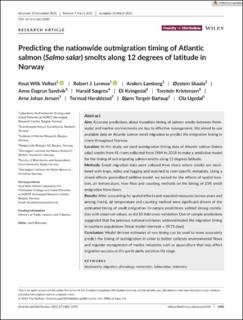| dc.contributor.author | Vollset, Knut | |
| dc.contributor.author | Lennox, Robert J. | |
| dc.contributor.author | Lamberg, Anders | |
| dc.contributor.author | Skaala, Øystein | |
| dc.contributor.author | Sandvik, Anne Dagrun | |
| dc.contributor.author | Sægrov, Harald | |
| dc.contributor.author | Kvingedal, Eli | |
| dc.contributor.author | Kristensen, Torstein | |
| dc.contributor.author | Jensen, Arne Johan | |
| dc.contributor.author | Haraldstad, Tormod | |
| dc.contributor.author | Barlaup, Bjørn Torgeir | |
| dc.contributor.author | Ugedal, Ola | |
| dc.date.accessioned | 2021-09-02T07:59:50Z | |
| dc.date.available | 2021-09-02T07:59:50Z | |
| dc.date.created | 2021-08-02T09:58:11Z | |
| dc.date.issued | 2021 | |
| dc.identifier.citation | Diversity and Distributions: A journal of biological invasions and biodiversity. 2021, 27 (8), 1383-1392. | en_US |
| dc.identifier.issn | 1366-9516 | |
| dc.identifier.uri | https://hdl.handle.net/11250/2772384 | |
| dc.description.abstract | Aim Accurate predictions about transition timing of salmon smolts between freshwater and marine environments are key to effective management. We aimed to use available data on Atlantic salmon smolt migration to predict the emigration timing in rivers throughout Norway. Location In this study, we used outmigration timing data of Atlantic salmon (Salmo salar) smolts from 41 rivers collected from 1984 to 2018 to make a predictive model for the timing of out-migrating salmon smolts along 12 degrees latitude. Methods Smolt migration data were collated from rivers where smolts are monitored with traps, video and tagging and matched to river-specific metadata. Using a mixed-effects generalized additive model, we tested for the effects of spatial location, air temperature, river flow and counting methods on the timing of 25% smolt emigration from rivers. Results After accounting for spatial effects and repeated measures (across years and among rivers), air temperature and counting method were significant drivers of the estimated timing of smolt emigration. In-sample predictions yielded strong correlation with observed values, as did 10-fold cross-validation. Out-of-sample predictions suggested that the previous national estimates underestimated the migration timing in southern populations (linear model intercept = 39.73 days). Conclusion Model-derived estimates of run timing can be used to more accurately predict the timing of outmigration in order to better calibrate environmental flows and regulate management of marine industries such as aquaculture that may affect migration success at this particularly sensitive life stage. | en_US |
| dc.language.iso | eng | en_US |
| dc.publisher | Wiley | en_US |
| dc.rights | Navngivelse 4.0 Internasjonal | * |
| dc.rights.uri | http://creativecommons.org/licenses/by/4.0/deed.no | * |
| dc.title | Predicting the nationwide outmigration timing of Atlantic salmon (Salmo salar) smolts along 12 degrees of latitude in Norway | en_US |
| dc.type | Peer reviewed | en_US |
| dc.type | Journal article | en_US |
| dc.description.version | publishedVersion | en_US |
| dc.source.pagenumber | 1383-1392 | en_US |
| dc.source.volume | 27 | en_US |
| dc.source.journal | Diversity and Distributions: A journal of biological invasions and biodiversity | en_US |
| dc.source.issue | 8 | en_US |
| dc.identifier.doi | 10.1111/ddi.13285 | |
| dc.identifier.cristin | 1923312 | |
| cristin.ispublished | true | |
| cristin.fulltext | original | |
| cristin.qualitycode | 2 | |

